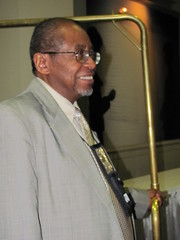Creating tomorrow's STEM workforce
By Debra Shapiro
Posted on 2010-03-20
Have you ever heard of Katherine Johnson, an African American woman who helped calculate the orbits that put Neil Armstrong on the Moon? Chances are you haven’t, says Garland Thompson, news correspondent for the Philadelphia Tribune, who is one of the first African Americans to join the editorial board of a major daily newspaper. He told the audience at his Shell Science Seminar today that while “talent is widely distributed among the human family,” Johnson and other minority and female STEM pioneers remain virtually unknown to today’s students. These are the people to point to as role models, he urged teachers.
In the 21st century, our country will have “so many things we need that we don’t have a workforce for,” said Thompson. “We need to train up a new crew to do that work.” Not all of these workers will be scientists and engineers: Many technical workers with associate’s degrees will be needed to make it all happen. Instead of focusing on the nation’s 52% dropout rate, he suggests turning to the students who aren’t dropping out and who just need some support on their road to a place in the STEM workforce. “Let’s not always talk about deficits,” he urged.
To create the new technical workforce, Thompson says teachers and curriculum writers should develop applied science and math lessons. He informs teachers that they and their students can attend–at no charge–conferences such as the Black Engineers of the Year Awards and Career Conference, to be held in Washington, D.C., next February. He calls this “an Oscar program for people in science and technology” and adds that companies often send recruiters to these events who are looking for bright students to hire.
“A lot of people like that will help you” by sending representatives to your school to talk to your students–or even “loaning” you an executive for the whole school year who can help you teach, observes Thompson. Lots of help is out there; “you just have to reach out and ask for it,” he points out.
Disclaimer: The views expressed in this blog post are those of the author(s) and do not necessarily reflect the official position of the National Science Teaching Association (NSTA).



